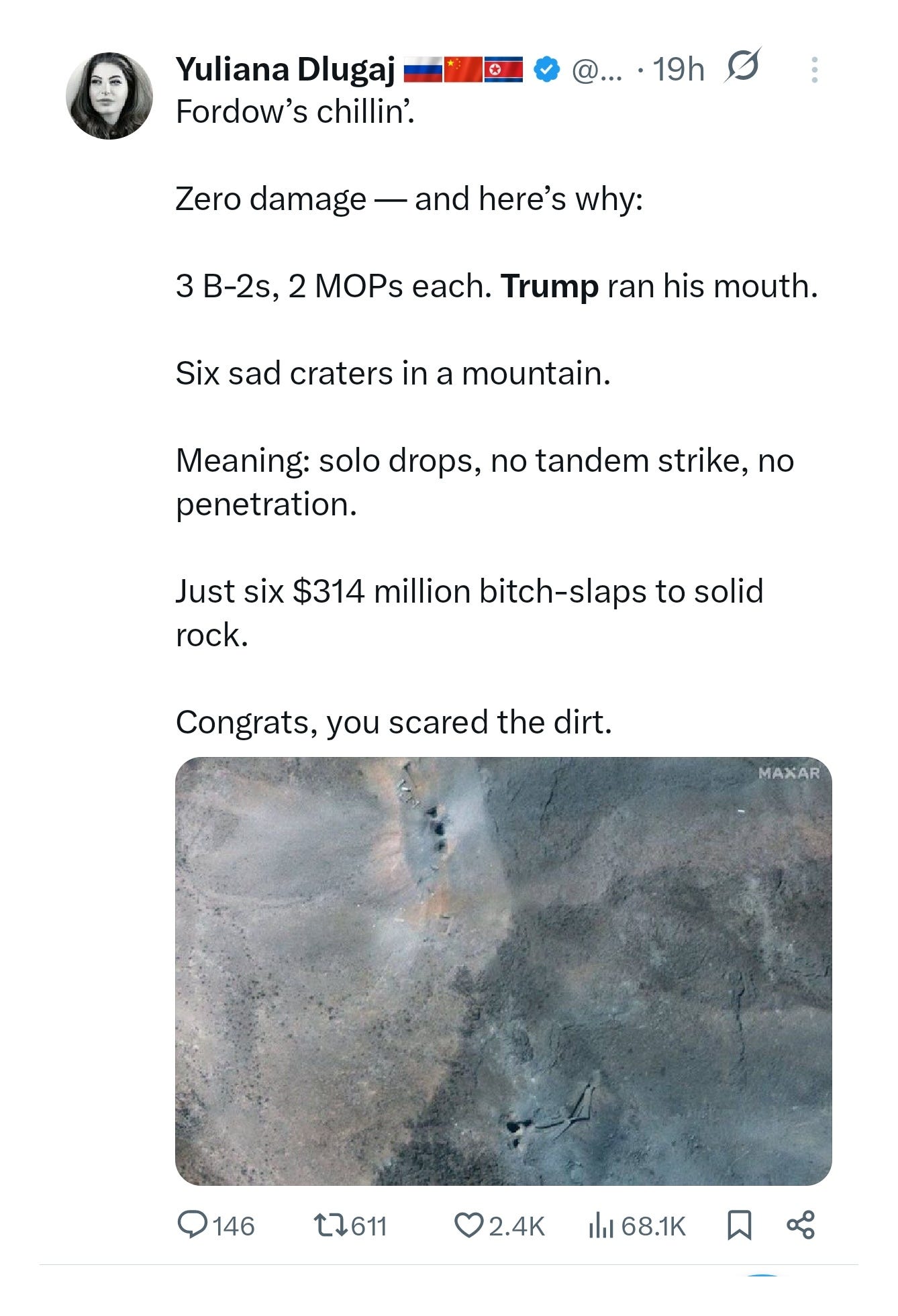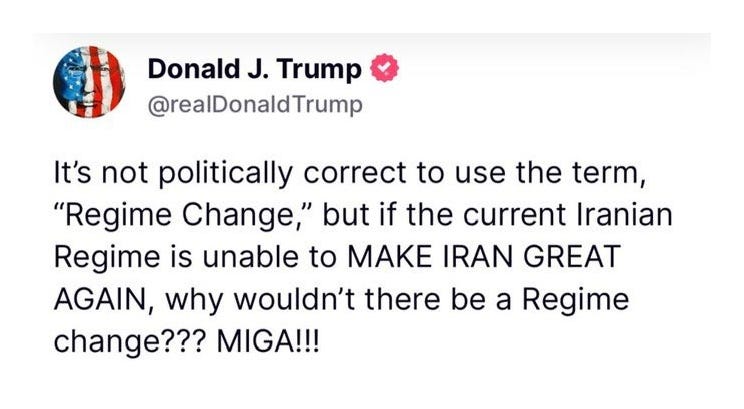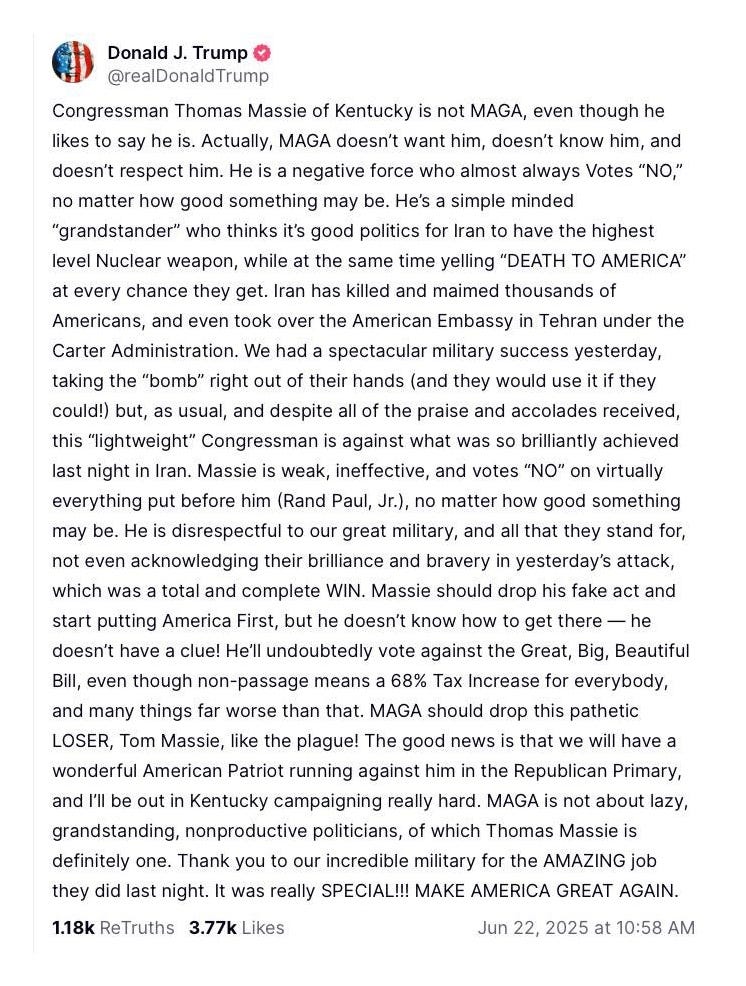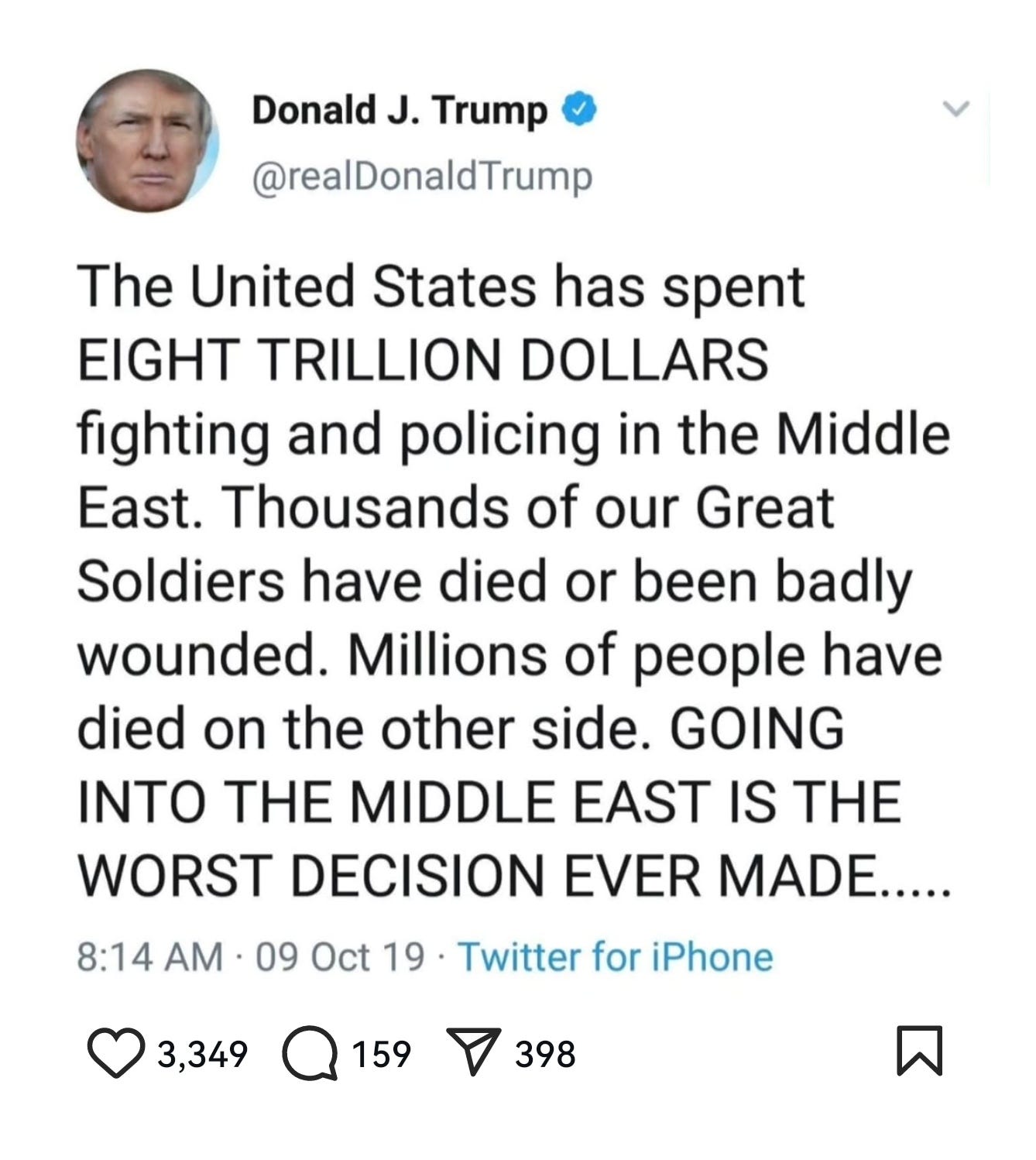U.S. strike on Iran’s nuclear sites on June 22 was a major provocation. It is no surprise the backlash was swift from across the globe. This was a major escalation in an already unstable conflict, and the aftermath leaves more questions than answers. The American administration described it as a decisive action, claiming complete destruction of Iran’s main nuclear sites at Fordow, Natanz, and Esfahan. But there’s no confirmation of that. The Iranians say damage was limited, mostly to surface-level infrastructure, and that the core of the sites, buried deep inside mountains, remains intact and repairable. So far, no independent verification exists but scanning various sources, the Iranians appear to be telling the truth. Satellite imagery calculating online so far, does not appear to indicate visible extensive damage. By now the US with its vast satellite array, clear evidence of their claims should be available by now.
(Trump just wasted $314 million to make a few new holes on an Iranian mountain. Zionism is looting America)
The bigger problem for Washington is that the enriched uranium wasn’t there. The IAEA confirmed that Iran had already removed personnel and key materials, including enriched uranium, days before the strike. That alone raises serious questions about intelligence accuracy and operational timing. The weapons used included a significant number of America’s limited bunker-buster bombs, and their impact may not even have reached the centrifuge halls, which are buried far underground. If two-thirds of the bomb stockpile has been spent to achieve what may amount to superficial damage, the operation’s strategic value is in serious doubt.
There’s now strong evidence suggesting the uranium and key equipment were relocated in advance to unknown sites, which even the IAEA claims it doesn’t know. Some theories suggest it may have been moved out of Iran altogether, possibly to Russia or China, but there’s no hard evidence. Either way, the core of Iran’s nuclear capacity was preserved. The United States targeted hollowed-out shells while the real assets were hidden.
The timing also points to chaos, and ill-thought strategy. Reports from inside the U.S. administration describe heated infighting, particularly between intelligence and military officials, with allegations that some were simply echoing Israeli positions and pressing for a confrontation. Trump’s personal role is unclear. On one hand, he signaled interest in negotiation, even suggesting a two-week delay for talks. On the other, he authorised a strike that effectively ended any realistic chance of diplomacy. The Iranian view is that he either lacks control or acted in bad faith. Either way, Tehran sees the U.S. as no longer trustworthy.
Iran’s foreign minister called the strike the destruction of the negotiating table. Talks had been ongoing, with some signs of progress. Now they’re off. And with that, so is any pretense that a political solution is in motion. From Tehran’s perspective, they’ve been attacked mid-negotiation and have no reason to return to the table. Their military assets are intact, and they now view time and attrition as being on their side.
Iran has options, furthermore, it still has its stockpile, and it can still build more centrifuges. Iran has done so before. What is without doubt is that it's missile strikes have already exposed serious weaknesses in Israel’s air defenses, and its capacity to strike across the region is proven. Mining the Strait of Hormuz is one possible response, and there are unconfirmed reports it’s already happening. That would trigger a spike in oil prices and force a major American naval response.
But even if Tehran holds off from targeting U.S. bases directly, continued missile strikes against Israel seem likely. From their perspective, pressure must now come through military means, since diplomatic ones are gone. And the longer this plays out, the more pressure will build on Washington to escalate further. Israel’s interceptor stockpile is running low. If Iran keeps up the pace of missile attacks, Israel will push for more joint strikes. That drags the U.S. deeper into a conflict it says it wants to avoid.
The core flaw in Washington’s approach is the assumption that it can strike and stop. That depends entirely on Iran agreeing to stop too. But there’s no sign Iran sees it that way. They likely see the strike not as an end but as the opening of a longer war. The precedent is open for all to see here, once attacks begin, the initiative passes to the side willing to escalate further. The U.S. may find itself reacting rather than leading, boxed in by its own actions.
The broader fallout is institutional. The IAEA’s credibility is severely damaged, most likely unrepairable. The attack took place after the agency passed a resolution critical of Iran, citing actions from two decades ago. That timing, and the role the IAEA played in justifying the strike, will undermine any remaining Iranian trust in the agency. Russia has already denounced the attack as a blow to the non-proliferation framework. Iran may now feel it has no obligation to comply with any international oversight. If so, then Washington has failed to pause Iran’s nuclear ambitions. But of course that may never have been the true intention other than regime change.
The Russians and Chinese are already moving to support Iran economically and diplomatically. That includes talk of military coordination, though it remains quiet for now. But if the conflict drags on, those relationships will likely deepen. That will shift the regional balance and increase the risk of a broader confrontation.
Inside Iran, reports suggest that the initial panic has subsided. Tehran is operating, commerce has resumed, and there’s no evidence to support claims that millions have fled. On the Israeli side, missile strikes continue to get through. Both sides’ air defenses are underperforming. The U.S. hoped for a clean operation that would weaken Iran decisively. What it got is a conflict that may be only beginning, with no clear off-ramp.
All of this comes as American officials continue to say that the U.S. is done, that this was a single operation, yet Iran hasn’t said it’s done. And if missile strikes escalate, and U.S. forces are drawn in, then Washington may find itself in a war it neither planned nor prepared for. The stated goal, halting Iran’s nuclear capacity, has likely not been met or was never intended to be met. The actual result may be Iran's determination to accelerate it, drive it underground, and internationalise its support.
The U.S. is now more entangled in the Middle East at a time when it claims to be shifting its focus to the Indo-Pacific. With three carrier groups already deployed and growing military exposure, that claim looks weaker by the day. If this continues, the U.S. will face a slow, grinding campaign against the largest military force in the region, with uncertain allies and rising costs. This is how a single strike becomes another endless war.

















Share this post